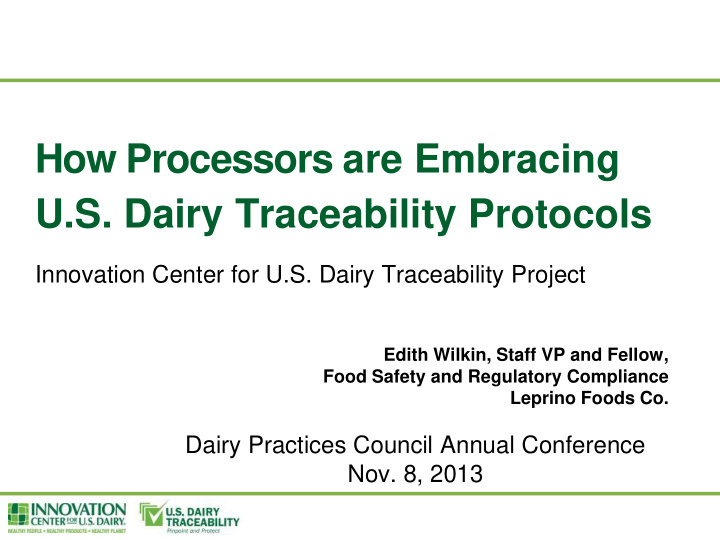



How Processors are Embracing U.S. Dairy Traceability Protocols Innovation Center for U.S. Dairy Traceability Project Edith Wilkin, Staff VP and Fellow, Food Safety and Regulatory Compliance Leprino Foods Co. Dairy Practices Council Annual Conference Nov. 8, 2013
Innovation Center background Funded by the dairy farmer checkoff Forum for industry to address pre-competitive barriers, opportunities to foster innovation and sales Commissioned globalization studies in 2009, 2011 conducted by Bain & Co. 2
Spinach Recall 2006-07 • E. Coli • 5 deaths • $350 million in lost sales 3
Tomato Recall 4
Enter Washington… 5
A Choice for Dairy Industry 6
Industry-led Effort TRACEABILITY SUBCOMMITTEE Dermot Carey Goal Chairman Ensure U.S. industry meets legislation, while meeting needs of Jeff Acker global buyers and competition Deliverable Barney Krueger Recommended voluntary , enhanced practices Clay Detlefsen Metric Edith Wilkin Degree of voluntary industry adoption to preempt FSMA Jeremy Travis 7
Research Findings Research analyzed by the Innovation Center task group showed that the U.S. Dairy industry: • Lacked lot-specific information • Failed to provide consistent information throughout the supply chain • Did not meet FDA documentation requirements Source: 2007 DMI Vulnerabilities Audit Report, 2009 OIG Report Traceability in the Food Supply Chain 8 8 8
Global Competitors Gaining For example, Oceania’s traceability practices exceeded the U.S. in: Use of technology Government standards External communications 9
3 Pillars of U.S. Dairy Traceability 1. Modeling physical plants 2. Creating lot- identifying mark 3. Enhancing record keeping 10
Pilot Study Tested Our Protocols Pilot program involved six Participants: processing companies, representing 30 percent of U.S. milk production Feedback and comments shaped final protocols, released Sept. 10 11
Helpful measuring stick “Comprehensive, straightforward and helpful." — Helena Soedjak, senior director of quality assurance and compliance 12
Fresh Perspective “Created more awareness of the impact of the various unit processes involved.” — Dermot Carey, senior vice president, ingredients division 13
New Insights “Led us to evaluate milk receipts, where we gained clarity on recall responsibility with our vendors.” — Scott Hall, corporate quality manager 14
Do Your Own Gap Analysis 15
Receiving • Farms on each load can be identified by receiving record or shipper. • For cream, condensed sugars and others the Lot Identifying Mark ties to shipper’s records. • Loads are recorded with silo destinations. 16
Warehouse • Lot Identifying Marks recorded when received matches shipper’s records. • Lot Identifying Marks recorded is same as is used by all operators at time of process use. 17 17
Process Areas • KDEs – Lot Entry Points are identified and listed. • Lot Identifying Marks are being recorded as ingredients are added. • Critical Tracking Events are identified and listed. • Critical Tracking Events • (Example: Silos, Tanks, Mixers) are not filled and emptied at the same time. • Critical Tracking Events are documented. 18 18
Clean-in-Place (CIP) • CIP type designated for Critical Tracking Event equipment. (Full, Sanitize) • CIP occurs on raw silos before refilling. • CIP resets Critical Tracking Event lot when complete. 19 19
Final Products • Product Lot Identity clearly identifies manufacturing lot. • Lot Identity is human readable, and electronically readable to the customer. • Lot Identifying Marks are recorded for packaging materials. 20 20
Records • Critical Tracking Event listings are current. • KDE – Lot Entry Point records are current. • Final products can be linked to Lot Identifying Marks they contain. • Lot Identifying Marks recorded are consistent throughout the facility. • Common points of convergence in products (Lot Identifying Marks) can be identified. 21 21
If You Don’t Know the Gap is There, How Can You Fix it? 22
Companies That Have Signed Commitment 23
Our Ambitious, but Attainable, 2014 Goal Commitment Level of 24
Window for Industry Action 25
How does this help your business? 6 Business Reasons to Embrace Enhanced Dairy Traceability 26
What You Can Do Next 1. Take the 21-point checklist back to your plant 2. Conduct a gap analysis 3. Urge your company to sign the U.S. Dairy Traceability Letter of Commitment 27 27
Resources for Information and questions Vikki Nicholson U.S. Dairy Export Council Staff & www.dairytraceability.com Traceability Subcommittee For More Information Innovation Center vnicholson@usdec.org 28
Thank You dairytraceability.com
Recommend
More recommend